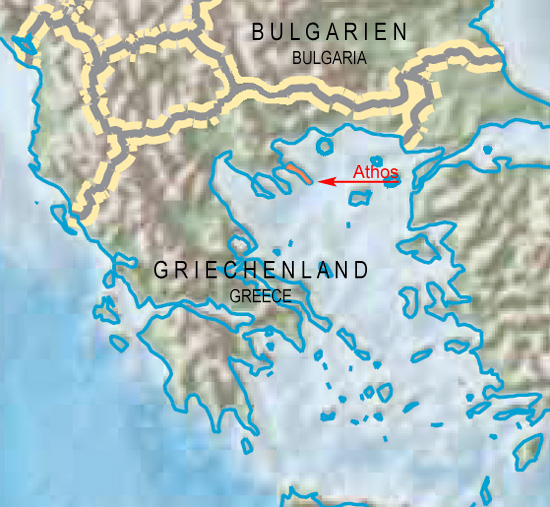mobile View, to the German Version tap the flag


- Autonomous monastic republic on the Khalkidhikí peninsula (Greece)
- own names: New Greek: Hagion Oros, Italian: Monte Santo, English: Holy Mountain
• Flag
• Meaning/Origin of the Flag
• Map
• Numbers and Facts
• History

Flag of Athos,
Source, by:
Wikipedia (D)




The flag of Athos with the double-eagle in the centre is a reminder of the old Byzantine flag. It shows the double-eagle, although in black on golden ground. It is really the symbol of Roman rule, which also survived in the flags of the Russian Czar, the Holy Roman Empire of the German Nation, or the Austria-Hungaryn Empire.
Source: Volker Preuß, Translator of the English text: Joachim Nuthack

Location:

Source: Map is Freeware, University of Texas Libraries, modyfied by: Volker Preuss

Area: 130 square miles
Inhabitants: 2.262 (2001), mostly Monks
Density of Population: 17 inh./sq.mi.
Capital: Karyä (Karyes, Karyaí), 163 inh. (2011)
important Monasteries: Dionysiu, Lávras, Panteleimon, Rossíki, Watopedhíon and Zográfu
official Language: Old-Greece (Koine)
other Languages: Modern Greek, Russian, Romanian, Serbian, Bulgarian
Currency: 1 Euro (€) = 100 Cent
Time Zone: GMT + 2 h
Source: Wikipedia (D)

10th cent. · formation of the initial monastic communities on Mount Athos
16th/17th cent. · Turkish occupation, the region comes to the Ottoman Empire, decline of the monastic communities
19th cent. · revival of the monastic live
1926 · loss of autonomy due to the affiliation with Greece
1969 · renewed granting of, however, only limited autonomy
Source: Wikipedia (D),
Discovery '97


![]()





